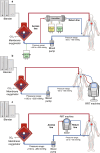Acute kidney injury in ECMO patients
- PMID: 34461966
- PMCID: PMC8405346
- DOI: 10.1186/s13054-021-03676-5
Acute kidney injury in ECMO patients
Erratum in
-
Correction: Selected articles from the annual update in Intensive Care and Emergency Medicine 2021.Crit Care. 2024 Apr 5;28(1):110. doi: 10.1186/s13054-024-04857-8. Crit Care. 2024. PMID: 38581042 Free PMC article. No abstract available.
Abstract
This article is one of ten reviews selected from the Annual Update in Intensive Care and Emergency Medicine 2021. Other selected articles can be found online at https://www.biomedcentral.com/collections/annualupdate2021 . Further information about the Annual Update in Intensive Care and Emergency Medicine is available from https://link.springer.com/bookseries/8901 .
© 2021. Ostermann and Lumlertgul.
Conflict of interest statement
MO has received research funding and speaker honoraria from Fresenius Medical Care and Baxter. NL reports no conflict of interest.
Figures


References
-
- Gao S, Liu G, Yan S, Lou S, Gao G, Hu Q, et al. Outcomes from adult veno-arterial extracorporeal membrane oxygenation in a cardiovascular disease center from 2009 to 2019. Perfusion. 2021; 10.1177/0267659121993365. [Epub ahead of print]. - PubMed
Publication types
MeSH terms
LinkOut - more resources
Full Text Sources

